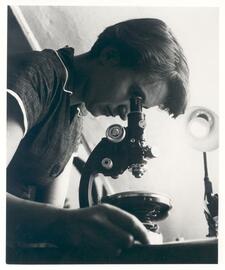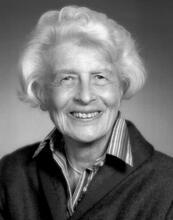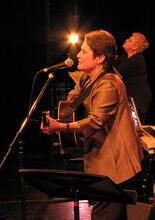Rosalind Elsie Franklin
The British scientist Rosalind Elsie Franklin (1920 – 1958), whose pioneering research helped lay the groundwork for the modern study and understanding of genetics, was known for her sociability and sense of fun, even as her independent thinking and unusual approaches meant that some of her most critical scientific work was done in isolation.
Institution: Online repository.
An influential British physical chemist, Rosalind Elsie Franklin earned her Ph.D at Cambridge in 1945 while researching the microstructure of coal, charcoals, and graphite. In 1947, she was offered employment in Paris; she spent the next three years there studying diffraction techniques. In 1950, John Randall recruited Franklin to work in his laboratory at King’s College, where he put her in charge of DNA diffraction studies. Franklin’s essential innovations, including her X-ray DNA photography and her work in distinguishing between “A” and “B” forms of DNA, allowed Frances Crick and James Watson to solve the structure of DNA as early as 1953. Her important role in their work went unacknowledged in most books and DNA science exhibits until the 1990s. Franklin died of ovarian cancer in 1958 at age thirty-seven.
Rosalind Franklin was an outstanding accomplished scientist, a fascinating individual with a strong personality, who made a lasting impression on everyone she met. Although best known for being the British physical chemist whose crucial experimental data enabled James Watson and Frances Crick to solve the structure of DNA as early as 1953, she received no gracious mention from either of them during their Nobel Prize speeches. Indeed, until 1968 when Watson wrote The Double Helix, she had only received vague credit for stimulating their work rather than specific credit for contributing to their original proposal. Although Anne Sayre’s 1975 biography discusses Rosalind Franklin’s contribution, it was unacknowledged in most books and DNA science exhibits until the 1990s. A British Museum Natural Science DNA exhibit in the 1960s omitted her name until a friend complained, but in March 2000, officials at King’s College, London named their new building the Franklin-Wilkins building, in honor of their two main DNA researchers. In addition to her expertise in the molecular structure of DNA, Rosalind Franklin was an expert in two other areas: the effects of heat on the microstructure of coal which included the changes that occurred during the conversion of some coals to graphite; and the quantitative analysis of the ultrastructure of the experimentally important RNA (Ribonucleic Acid) virus and TMV (Tobacco Mosaic Virus).
Family & Education
Rosalind Franklin was the second of five children born to Ellis Franklin (1894–1964) and Muriel (Waley) Franklin (1894–1976), both members of educated and socially conscious Jewish families that had arrived in England during the 1700s and 1800s. Rosalind’s father Ellis maintained the family wealth by following the Franklin tradition of merchant banking. Rosalind grew up surrounded by brothers—her older brother David, and her younger brothers Colin and Roland—until the birth of her sister Jenifer nine years later. From them Rosalind learned about competition, sports, and other things more typically of interest to boys—and often took to them more than her brothers. Although Ellis was much more politically conservative than his relatives, they were a close immediate family, prone to lively discussion and vigorous debates at which, according to sister Jenifer, the highly intelligent, logical, determined and articulate Rosalind excelled. Rosalind had such a strong independent streak that she would even argue with her assertive father. She was also unusual in that she ignored dolls, greatly preferring to craft items, draw, photograph, or read. Later in life she used her talent as an artist and machinist to first sketch, and then build her own molecular models and equipment. Even at a young age, Rosalind manifested the creativity and drive characteristic of the Franklin women, who were expected to focus their education, talents and skills on political, educational, and charitable forms of community service. Therefore, it was fairly unusual that young Rosalind expressed an early fascination with physics and chemistry classes at the academically rigorous St. Paul’s Girls’ School, and even more unusual that she earned a natural sciences degree, with a specialty in chemistry, at Newnham College, Cambridge in 1941. There she became close friends with French physicist Adrienne Weil, who greatly influenced Rosalind’s intellectual and independent development, as well as her affinity for French customs. However, during university vacations, Rosalind dutifully followed the family tradition of community service by working with the German-Jewish Refugee Committee at Woburn House, the London headquarters of the major Anglo-Jewish organizations.
Early Career
Rosalind’s “upper second” on her Cambridge final degree examinations qualified her for a graduate research scholarship, but she did not interact well with her supervisor, Professor R.G.W Norrish. One contributory reason, he expressed to Franklin biographer Anne Sayre, was that he did not approve of Rosalind’s interest in “raising the status of her sex to equality with men.” Instead, since Rosalind Franklin loved precise scientific experimentation, from 1942 to 1946 she did war-related work for the British Coal Utilization Research Association (BCURA). Stemming from her independent research there on the microstructure of coal, charcoals, and graphite, she published five fundamental and frequently cited papers, thereby earning her Ph.D. from Cambridge in 1945, as well as an offer of employment in Paris. Working with Jacques Méring at the Laboratoire Central des Services Chimiques de l’État between 1947 and 1950, she became proficient at applying X-ray diffraction techniques to imperfectly crystalline matter like coal—a skill responsible for her being recruited to work on DNA fibers. She maintained her interest in coal research throughout her professional career, almost annually publishing a paper on the structure of carbons.
During the four years Rosalind Franklin studied diffraction techniques with Méring in Paris, she passionately enjoyed both her professional and personal life. She made many friends in the laboratory, and often hiked with them on weekends. She preferred to live on her own modest salary, and frustrated her parents by continually refusing to accept money from them. She loved to travel and hike throughout Europe, preferring modest third-class accommodations to the first class her family could well afford, for the opportunity it provided her to pick up the rudiments of many languages and converse with everyday people in their own language. She excelled at speaking French and at French cooking and soon became more comfortable with egalitarian “French ways” than with conventional English customs.
Work at King’s College
Franklin seriously considered staying in France, but under professional advice from Dorothy Hodgkin about future scientific opportunities in England versus France, and because of pressure from her family, Rosalind decided to return home to England. Her experience in applying X-ray diffraction to non-crystalline substances influenced Professor John Randall, director of a special biophysics unit at King’s College, London, to recruit Rosalind to work in his laboratory, not realizing that Rosalind’s “French ways” and non-traditional tendencies would become a source of continual friction. Rosalind was just too different from everyone else at King’s in too many ways.
After Rosalind Franklin started working in Randall’s unit at King’s in January 1951, the consequences of her being so different were accentuated by the personality mismatch between herself and fellow DNA researcher Maurice Wilkins. She was quick, intense, assertive, and directly confrontational, while he was exceedingly shy, indirect and more slowly calculating to the point of appearing plodding. Even so, the problems these differences created might have stayed limited to a tolerable level except for a serious misunderstanding initiated by Randall. He had clearly handed over the DNA diffraction studies to Rosalind Franklin without informing Maurice Wilkins, who had most recently been working on DNA structure at King’s. He had also neglected to inform Franklin of his support for Wilkins’s continued interest in DNA. This promoted such hostility between these two that Franklin performed her precise and detailed technical work in professional isolation, with only graduate student Raymond Gosling for assistance and intellectual discussion.
Impact on Watson & Crick
Wilkins was as frustrated with Franklin as she with him, yet many unfairly assign blame to just one of them for their inability to collaborate. Unfortunately Wilkins expressed some of his frustration by talking more than he would otherwise have to his friends Watson and Crick, their competitors at Cambridge University, naively supplying them with crucial data based upon his and Rosalind’s work. When he showed Watson Rosalind’s best DNA photograph (#51), its wealth of information was enough to start them on the correct solution to DNA. He also informed them of the existence of an internal King’s Medical Research Council report containing a summary of Rosalind’s latest findings, which they requested from their colleague Max Perutz the next day. Watson and Crick began building the correct backbone of their famous model of DNA less than two weeks after learning crucial helical parameters from these two Franklin sources. At approximately the same time, Rosalind Franklin started writing a draft paper specifying her DNA findings, which she finished one day before Watson and Crick completed their paper. Rosalind had been able to draw out exceptionally fine DNA fibers which, when properly hydrated and examined under the new equipment she had designed and ordered, enabled her to quickly establish the crucial differences between the “A” and “B” forms of DNA. This important distinction allowed her to use complex cylindrical Patterson methods on her high resolution “A” photographs to properly locate and then measure the positions of the backbone phosphate groups on the outside and the nitrogenous bases on the inside of what she correctly hypothesized to be a double stranded helical molecule. She measured the unit cell dimensions and classified the space group as C2, but did not realize, as Crick did, its implication that the two sides of the sugar-phosphate backbone must run in opposite directions (anti-parallel). Her photograph #51 was clear enough to allow her to precisely determine the 34 angstrom helical repeat and the 20 angstrom helical diameter. Upon learning of Watson and Crick’s model, Rosalind rewrote her own draft manuscript as a supportive paper to be published in the same April 1953 issue of Nature. She never knew that her data critically contributed to the Watson and Crick proposal. With hindsight, several of Franklin’s new precise findings could also be inferred from formerly published poorer data, but these older data had not sufficiently stimulated Watson and Crick to build a correct model, whereas Franklin’s had. Also Franklin’s distinguishing between the “A” versus “B” forms of DNA, her measuring the unit cell dimensions, and her identifying the space group which indicated the anti-parallel nature of the backbone, were all new essential pieces of information.
Perceptions of Franklin
Unfortunately, the most popular source of information on Rosalind Franklin and DNA is Watson’s infamous work The Double Helix, written from the viewpoint of the brilliant but still immature and egotistical Watson of the 1950s, and based on only three short meetings with Franklin. In it he creates a cruel caricature of Franklin that omits her finer attributes while emphasizing and distorting her more negative qualities. Sounding like a misogynist, Watson paints a misleading, physically unattractive, and hostile image of Franklin as if this had anything to do with her professional competence. Ironically, simultaneously, he for the first time publicly gives her work widespread proper credit.
Compared to other laboratories, Randall’s MRC unit provided an unusually supportive environment for eight additional women researchers who demonstrated more “appropriate” behavior than Franklin. Their behavior did not include Franklin’s habit of leaping into passionate argumentative debate, or her unusually serious, uniquely stubborn and even abrasive style at work. In contrast, when she was not working, Rosalind Franklin was very sociable and was known for her intellectual interests, her passionate love of life and her sense of fun. She routinely lunched amicably with several MRC colleagues in the informal, mixed Committee Dining Room. None of the women were allowed to enter the more formal men’s-only Senior Common (dining) Room, the existence of which irritated Rosalind greatly. Most people thought Rosalind very attractive with her graceful long slender figure, fashionable tailored dress and brilliant eyes. She had numerous close lifelong friends who, together with their children, adored her company and even tolerated her preference for third-class accommodations and rigorous hikes for the sheer fun of traveling with her.
Post-King’s College & Death
By 1953 Franklin was sufficiently unhappy at King’s that she left to work with the eminent biocrystallographer, Desmond Bernal, at Birkbeck College in London. Within five years she published seventeen papers on TMV, five alone, and twelve in collaboration with the team she directed. She proved that TMV’s peripheral-helically packaged protein component surrounded and embedded its linear strand of infectious RNA, approximately halfway out from its central hollow core. This was probably the first example of structural virology.
In 1956 Rosalind Franklin traveled widely in the United States and had fallen in love with one of the scientists she met, but she soon suffered the first symptoms of the ovarian cancer that was to cause her untimely death, so she immediately ended the relationship with this man. Two years later she died of the disease, at the age of thirty-seven. Always preferring to live on her modest salary, she left most of her inherited money to charity. In her obituary, Bernal stated, “As a scientist, Miss Franklin was distinguished by extreme clarity and perfection in everything she undertook. Her photographs are among the most beautiful X-ray photographs of any substance ever taken.” In 1982, when her closest Birkbeck colleague Aaron Klug received the Nobel Prize, he credited Rosalind Franklin during his acceptance speech with setting “the example of tackling large and difficult problems.”
Chomet, Seweryn. editor. D.N.A. Genesis of a Discovery. London: Newman-Hemisphere, 1995
Crick, Frances. What Mad Pursuit. New York: Basic Books, 1988
Glynn, Jenifer. My Sister Rosalind Franklin. Oxford, England: Oxford University Press, 2012.
Glynn, Jenifer (Franklin). “Rosalind Franklin.” In Cambridge Women: Twelve Portraits. Edited by Edward Shils and Carmen Blacker. Cambridge, England: Cambridge University Press, 1996
Judson, Horace Freeland. The Eighth Day of Creation: The Makers of the Revolution in Biology. New York: Simon & Schuster, 1979. Expanded Edition, New York: Cold Spring Harbor Laboratory Press, 1996
Klug, Aaron. “Rosalind Franklin and the Discovery of the Structure of DNA.” Nature 219 (1968): 808–813
Klug, Aaron. “Rosalind Franklin and the Double Helix.” Nature 248 (1974)
Maddox, Brenda. Rosalind Franklin: The Dark Lady of DNA. New York: Harper Perennial, 2002
McGrayne, Sharon Bertsch. Nobel Prize Women in Science. New York: Birch Lane Press, 1993
Olby, Robert. The Path to the Double Helix. Seattle, Washington: University of Washington Press, 1974
Perutz, Max. “Letter to the Editor.” Science 164 (1969):1537–9
Piper, Anne. “Light on a Dark Lady.” Trends in Biochemical Sciences (268) volume 23 (1998): 121–156
Sayre, Anne. Rosalind Franklin and DNA. New York: Norton, 1975
Watson, James D. The Double Helix, Critical Edition ed. Gunther Stent. New York: Norton, 1980. (original edition was published in 1968)
Watson, James. “Letter to the Editor” (in response to Perutz). Science 164 (1969):1539










